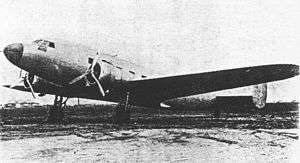PZL.44 Wicher
| PZL.44 Wicher | |
|---|---|
 | |
| Role | Passenger plane |
| Manufacturer | Państwowe Zakłady Lotnicze |
| First flight | 12 March 1938 |
| Retired | 1939 |
| Status | Prototype |
| Primary user | LOT Polish Airlines |
| Produced | 1938 |
| Number built | 1 (prototype) |
|
| |
The PZL.44 Wicher was a prototype of 14-seat, twin-engine Polish airliner, built in the Państwowe Zakłady Lotnicze (PZL) in 1938. It was to compete with the DC-2 and Lockheed Super Electra.
Design and development
In mid-1930s the Polish Ministry of Communication ordered a development of an own passenger plane for LOT Polish Airlines, using imported airliners so far, mostly Lockheed Model 10 Electra and DC-2. The plane was designed in the state factory Państwowe Zakłady Lotnicze under direction of Wsiewołod Jakimiuk in 1936-1937.
The prototype was flown on March 12, 1938 by Bolesław Orliński. The aircraft was designated PZL.44 Wicher (strong wind). In December 1938 it was given to LOT for evaluation, with registration SP-BPJ. Initially LOT airlines ordered 10 PZL.44s but high cost of a single plane and delays in development were reasons for decreasing order to 4, then for cancelling it in 1939. LOT bought a batch of 10 cheaper Lockheed Model 14 Super Electra in 1938 and 1939 instead.
Wicher was the first modern airliner designed in Poland. Its construction was very modern, but it is estimated, that the whole program was too ambitious, because a development of an own passenger plane, without much hope of export, was unprofitable. Moreover, LOT airlines found operation features of well-proven Lockheed Super Electra more satisfactory. Lockheed offered a possibility of licence production as well. Besides, the Wicher development caused delays in development of new fighter aircraft, like PZL.50 Jastrząb, that were more needed in an advent of the war.
Operational history

After the outbreak of World War II, on 1 September 1939, the prototype was evacuated from Warsaw to Lwów, but it damaged a landing gear and was left there. It was next captured by the invading Soviets and evaluated in Moscow.
Variants
Only one prototype was built.
Operators
- LOT Polish Airlines operated single prototype and was expected operator of a series.
Specifications (PZL.44)
Description
Twin-engine low-wing cantilever monoplane of all-metal construction, metal covered (with Alclad sheet). Fuselage semi-monocoque. Crew cockpit in front with a crew of 4: two pilots, radio operator and a mechanic. Passenger cab with 14 seats in two rows, dimensions: length 9 m, width 1.7 m, height 1.85 m. In the rear, WC and (planned) buffet with steward's seat. Crew doors on the left in front, passengers' doors on the left at the rear. Baggage space was between cockpit and the passenger cab and in a tail section, capacity: 5 m³. Elliptical wing (shape similar to PZL.37 Łoś bomber). Engine nacelles in wings. Three-blade Hamilton Standard propellers. Retractable conventional landing gear - main gear with single wheels retractable to engine nacelles. Double elliptical tailfin. Fuel tanks 2200 l in wings (normal load 1800 l).
General characteristics
- Crew: 4
- Capacity: 14 passengers
- Length: 18.45 m ()
- Wingspan: 23.8 m ()
- Height: 4.8 m ()
- Empty weight: 5,990 kg ()
- Useful load: 3510 kg ()
- Loaded weight: 9,500 kg ()
- Powerplant: 2 × Wright Cyclone GR-1820 G2 9-cylinder radial engines, 1000 hp () each
Performance
- Maximum speed: 374 km/h
- Cruise speed: 316 km/h
- Stall speed: 110 km/h ()
- Range: 1,800 km (max 2,200 km) ()
- Service ceiling: 6,000 m ()
- Rate of climb: 6.1 m/s (1,030 ft/min)
- Wing loading: 127 kg/cm² ()
References
- Andrzej Glass. Polskie konstrukcje lotnicze 1893-1939 (Polish Aviation Constructions 1893-1939). Warsaw: WKiŁ, 1977 (Polish language, no ISBN).
See also
| Wikimedia Commons has media related to PZL.44 Wicher. |
- Aircraft of comparable role, configuration and era